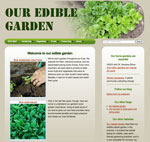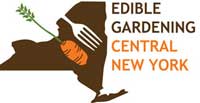Our Vanishing Night: Light Pollution
|
 | | The eastern seaboard at night |
| |
|
A World of Health: Connecting People, Place, and Planet
|  | |
Living Green, Living Good in CNY (www.lglgcny.org) is sponsoring the Northwest Earth Institute's discussion course A World of Health: Connecting People, Place, and Planet.
The course discusses limitations of the current medical model and its approach to health, then addresses the places where our personal health intersects with the environment - from our food and homes, to our communities and society. Throughout the course you will find individual actions that promote good health and in turn, promote a healthier environment.
Here's more information about this course.
We'll meet once a week for six weeks. The dates for the course are the six Fridays from April 5 to May 10 at 7:00 pm at our home in Westvale.
OCPL has purchased a set of course books that can be checked out, so participation is free for the first 8 people who register.
If you're interested
in learning more about participating, contact Janet Allen.
|
Learn how to protect our Onondaga Lake
Watershed
|  |
Join habitat restoration experts at the Onondaga Lake Visitors Center as they provide the tools and information that will help make us all better environmental stewards. Discover the intricate connections between habitat improvements and the protection of birds and wildlife. When: Sat. Mar. 23 from 9:30 am to 11:30 am Space is limited. RSVP to the Montezuma Audubon Center at montezuma@audubon.org with the subject line "Onondaga Lake" or call 315-365-3588 by March 15.
|
| Lagoon Park Restoration Project |
 | | Spicebush swallowtail |
|
Walking paths, bridges, fishing platforms, and lookouts are all part of the Lagoon Park. Unfortunately, as Jim Engel pointed out, a sizable portion of the park has been overtaken by invasive plant species, particularly European Buckthorn. Two years ago, Engel, the owner of White Oak Nursery in Geneva, asked the City of Canandaigua for permission to restore the natural beauty of the Park by removing the invasive growth and planting flora and trees native to the Finger Lakes such as Spicebush, Nannyberry, and Arrowood Viburnum to name a few. The City gave Engel permission to proceed on the project, but no funding. Learn more about this project and how you can help fund it.~ From Amanda's Garden newsletter |
| Our Habitat Garden |  |
Visit Our Habitat Garden website for information on providing habitat, earth-friendly gardening practices, plants, and various creatures here in Central New York.
|
HGCNY Officers
| |
| President:
Janet Allen
Vice-President:
Carol Biesemeyer
Treasurer:
Randi Starmer
Secretary:
Soule Leiter
Membership:
Linda Rossiter
Program Chair:
Carol Biesemeyer
Newsletter Editor:
Janet Allen
Additional Planning Committee Members:
Beth Mitchell
Dave Mitchell
John Allen
|
| HGCNY on Facebook |
As as more of us participate on our Facebook page, this will become a useful resource for asking (and answering!) local HGCNYers' questions about habitat gardening. |
|
Join HGCNY!
|  |
Becoming an official member of HGCNY is easy: just join Wild Ones! Basic household membership is $37/year, but there are other options, too. (See membership application or website.)
Wild Ones
P.O. Box 1274
Appleton, Wisconsin 54912-1274
Make checks payable to Wild Ones.
Or telephone toll-free 877-394-9453.
|
|
Our Edible Garden
|  | Visit OurEdibleGarden.org to see an example of a Central New York edible garden, the perfect companion to your habitat garden.
|
| Interested in Edible Gardening? | 
|
If you'd like to get information on Edible Gardening CNY, just email John to find out about edible gardening tours and monthly programs. Free and open to the public! |
|
Greetings!
 | Serviceberry cultivar --
with few berries! |
Dan Segal of The Plantsmen Nursery in Ithaca - and a national Wild Ones Board member - will present "Cultivars of Native Plants: Thanks But No Thanks." Cultivars have overtaken mainstream horticulture because they are the currency of mass production and mass marketing. Now the cultivar epidemic threatens native plants too. Find out how and why this is happening, and how cultivars undermine the fundamental principles of ecology without which native plants are just pretty faces lacking substance. When: Sunday, March 24 at 2:00 pm Where: Liverpool Library ( Directions) Free and open to the publicLooking ahead
Our final regular program this year will be: Sun. April 28: Jim D'Angelo will return to talk about another creature in our habitat gardens. Monarch programsI'll be giving presentations about Creating a Monarch and Butterfly-friendly yard at the following times and locations:
Wed. March 20 at 7:30 pm Sierra Club Meeting at University United Methodist Church 1085 E. Genesee St. Syracuse
Tues. April 23 at 6:30 pm Fulton Public Library
Sat. May 4 at 10 am at Baltimore Woods Nature Center
Sat. May 4 at 3 pm at Beaver Lake Nature Center
Wed. May 8 at 6:30 pm Liverpool Public Library
Thurs. June 13 at 7:00 pm Dewitt Community Library
Janet Allen President, HGCNY |
|
|
The importance of species
 | | Native rose with small bees |
If wild rose blossoms are pink, single, and bloom in June, if wild rose hips are red, small, and hang on the canes all winter, then planting large-hipped everblooming yellow doubles is bound to sabotage someone's expectations.
Since a hybrid may look the part but carry hidden defects, I favor species.
And since the genetic encyclopedia that plants carry was written in the historical context of their native land, I try to buy Americans.
~ Sara Stein, Noah's Garden: Restoring the Ecology of Our Own Back Yards, p.72, 1993
|
|
Coffee and birds
 | | Bird-friendly certified coffee |
Choosing Bird-friendly coffee helps ensure that the migratory neo-tropical birds we enjoy in the summer will have habitat in the winter during their stay in Central America. Since the 1970s, more and more coffee is produced in sun plantations, which are virtually biological deserts. And since coffee naturally grows in the shade, growing in sun requires the use of many chemicals.  | | Look for this official Bird-Friendly certification logo |
Until recently, the problem has been to find coffee that is certified as Bird-Friendly. Now it has become easier! Wild Birds Unlimited sometimes has Birds and Beans coffee, and Wegmans now carries one type of Bird-Friendly coffee. Now you can enjoy watching birds while drinking your morning cup of coffee, knowing that you're not only providing summer habitat, but winter habitat, too! For more information about coffee and birds... |
|
Climate and butterflies
 | Giant swallowtails
are moving north
|
Recent research shows a large change in butterfly populations in Massachusetts due to climate change.
Native cold-weather butterflies -- especially those that overwinter as eggs or larvae -- are in decline, and butterflies from the south are arriving.
The key to this research was 19 years of sightings by the Massachusetts Butterfly Club, an organization of amateur butterfly enthusiasts.
Average temperatures in Massachusetts have increased by about 3.6 degrees F. since 1900.
As the world changes in unpredictable ways, citizen scientists will play an increasingly important role. YOU can be a citizen scientist!
Read more about this study.
|
|
Cover the ground with natives!
 | Wild ginger with some ferns
|
There's no need to rely on the over-used, non-native groundcovers such as pachysandra, vinca, or English ivy.
And there's no need to cover the ground with turf grass with all its associated problems.
This year, start covering the ground with natives!
There are natives for every condition. Be sure to match your growing conditions with plants that like those conditions, and you'll be on your way to a earth-friendly and beautiful yard.
And there's no rule that an area with ground cover has to have only one kind of plant!
For SUNNY, DRY conditions:
Barren strawberry (Waldsteinia fragarioides)
Moss phlox (Phlox subulata)
Lowbush blueberry (Vaccinium angustifolium)
Bearberry (Arctostaphylos uva-ursi)
Hayscented fern (Dennstaedtia punctilobula) (This is aggressive, but useful in the right situation.)
PART SUN to SHADE; REGULAR to MOIST SOIL
Foam flower (Tiarella cordifolia)
Alumroot (Heuchera americana)
Labrador violets (Viola labradorica)
Wild geranium (Geranium maculatum)
Golden ragwort (Senecio aurea)
Woodland phlox (Phlox divaricata)
Jacob's ladder (Polemonium reptans)
Maidenhair fern (Adiantum pedatum)
New York fern (Thelypteris noveboracensis)
Mayapple (Podophyllum peltatum)
Pennsylvania sedge (Carex pensylvanica) (This can be a lawn alternative.)
WOODLAND or DEEP SHADE
Wild ginger (Asarum canadense)
Wild stonecrop (Sedum ternuum)
Wintergreen (Gaultheria procumbens)
White wood aster (Eurybia divaricata)
Heart leaved aster (Symphyotrichum cordifolium)
Blue wood sedge (Carex glaucodea)
Seersucker sedge (Carex plantaginea)
|
|
Cherry Blossom Blitz
citizen science
 | | Wild cherry |
Here's an easy way to get involved in citizen science.
Project Budburst's Cherry Blossom Blitz is a six week campaign from March 1 - April 30, designed to get people outside collecting continental scale cherry blossom data for science.
Last November, scientists studying cherry blossom phenology used data from Project BudBurst to test their models about changing blossom times. The Cherry Blossom Blitz will provide scientists and the public with even more data to track changes in cherry tree blossoms.
The more people participating across the country, the better the geographic coverage and the more useful the data is to our scientists. Scientists can use your data to look for general trends, to see if the data can provide "ground-truthing" to better understand remotely sensed data such as that taken by satellites or cameras, and more.
For this project, any cherry tree will do -- native or not.
Designed with your busy schedule in mind! It takes just a few minutes to make a difference!
Read more about how to participate on the Project BudBurst website.
Project BudBurst resources for educators at all levels
If you are looking for ways to bring science to life, Project BudBurst can help. Project BudBurst has many resources for a variety of educational settings -- K-4, Grades 5-8, and Grades 9-12.
They also have resources for informal education as well as for colleges and universities.
Learn more about these resources for educators.
|
|
|
|
|